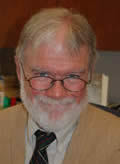
“Bourdon” is a rare and splendid word, not the sort of word you use every day, but certainly a word to lift your hat to, as Emily Dickinson once said of the word “phosphorescence.” Among its meanings is the continuous base note struck by a bagpipe.
It was wonderfully used by Father Herbert Thurston, the English Jesuit scholar who contributed hundreds of elegantly written articles to the Catholic Encyclopedia, including one on the history of the rosary.
“The objection so often made against its ‘vain repetitions,’” Thurston wrote of the old bead-telling prayer, “is felt by none but those who have failed to realize how entirely the spirit of the exercise lies in the meditation upon the fundamental mysteries of our faith. To the initiated, the words of the angelical salutation form only a sort of half-conscious accompaniment, a bourdon which we may liken to the ‘Holy, Holy, Holy’ of the heavenly choirs and surely not in itself meaningless.”
Thurston, whose rosary article was published in 1912, was an almost stereotypical Jesuit intellectual. His dislike of pious sentimentality gave his scholarship a tone of breezy skepticism that occasionally made it controversial. His narrow-eyed approach to popular devotions and religious lore even gave rise to the apocryphal story that a dying Jesuit confrere once begged him to “spare the Blessed Trinity.”
Remarkably, however, Thurston is reputed to have had a devotion to the rosary, that monotonously repetitive prayer which, as he insisted, could be “adapted alike for the use of simple and learned.”
Catholics of a certain age and disposition — all right, Catholics of my age and disposition — may be forgiven for feeling a bit squeamish in approaching the rosary. For those of us who came of age in the 1960s with the words of a new Mass in English displacing the Latin rubrics we’d memorized, the rosary, much like novenas, Forty Hours, First Friday Mass and Benediction, can seem an antique curiosity. We tend to associate it with a sentimentalized and unreflective religiosity, a prop used in comedy skits about uptight nuns, a politely tolerated inconvenience in funeral chapels, a fetish brandished in Catholic defiance or even an accessory for a gangbanger.
We may be forgiven, but not excused. Unless Christian belief is utter nonsense, nothing human beings do is more important than prayer. And as anyone who tries knows, nothing is more difficult to do than to pray. Prayer is work. It goes against the grain of our preference to be content with the diminished world we struggle so hard to make our home. It’s difficult to avoid the suspicion that our complaints against the monotony, sentimentality and vacuity of the rosary (or similarly well-worn devotional practices) disguise a simple reluctance to do the work of prayer.
The fact that the rosary can so easily become a mere habit is precisely what ought to recommend it. William Willimon and Stanley Hauerwas extol such habits in the remarkable book, The Lord’s Prayer and the Christian Life. “Habit is good,” they write. “Most of the really important things we do in life, we do out of habit. We eat, sleep, make love, shake hands, hug our children out of habit. Some things in life are too important to be left to chance. Some things in life are too difficult to be left up to spontaneous desire — things like telling people that we love them or praying to God. So we do them out of habit.”
I’ve been trying to take up the habit again. Early one recent Thursday morning, as much to distract myself from calisthenic agony as to worship, I prayed a rosary while attempting to jog around Saint Joseph’s Lake on the Notre Dame campus, counting off Hail Marys on my fingers and fitfully considering the Luminous Mysteries.
Then the bourdon struck its note. The susurrus mantra I was panting kept tempo with the rhythmic thump of my flat feet on the lakeside path, suffusing the tolerable but insistent ache of my arthritic joints and taxed lungs. With Mary, I contemplated her miracle-working, word-proclaiming, transfigured and self-outpouring Son as daybreak brightened and burned through a snowstorm of cottonwood pollen.
I was running blind into that morning phosphorescence but knew that I soon would see Him all too clearly.
Michael Garvey is Notre Dame’s assistant director of public information and communication. Email him at garvey.2@nd.edu.